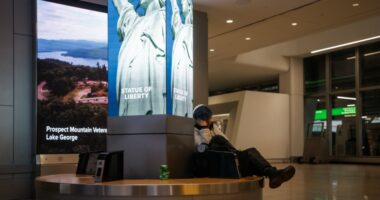Share this @internewscast.com

(NEXSTAR) People from a dozen countries will soon be barred from entering the U.S., while those from seven others face expanded travel conditions, after President Donald Trump signed a travel ban on Wednesday.
The ban, which Trump said was brought on by national security concerns, takes effect on Monday, June 9, and is similar to an order issued during his first term. Additional countries may also be added to the list “as threats emerge around the world,” Trump said in a video posted Wednesday.
For now, however, you don’t necessarily need to reconsider any travel plans you have.
Who is impacted by Trump’s travel ban?
First, the order is focused on people entering the United States. More specifically, it fully restricts the entry of nationals from the following countries, as previously reported by The Hill:
- Afghanistan
- Chad
- Republic of the Congo
- Equatorial Guinea
- Eritrea
- Haiti
- Iran
- Libya
- Myanmar
- Somalia
- Sudan
- Yemen
Nationals coming to the U.S. from Burundi, Cuba, Laos, Sierra Leone, Togo, Turkmenistan, and Venezuela will also face partial restrictions under Trump’s order.
Existing visa holders, lawful permanent residents of the U.S., and those “whose entry serves U.S. national interests” from those 19 countries are exempt.
Other exempt travelers include certain athletes and coaches traveling for major sporting events as determined by the U.S. secretary of state; Afghans who worked for the U.S. government or its allies in Afghanistan and are holders of Afghan Special Immigrant Visas; Iranians belonging to an ethnic or religious minority who are fleeing prosecution; certain foreign national employees of the U.S. government who have served abroad for at least 15 years and their spouses and children; refugees granted asylum or admitted to the U.S. before the ban; individuals with U.S. family members who apply for visas in connection to their spouses, children or parents; diplomats and foreign government officials on official visits; those traveling to the U.N. headquarters solely for official business related to the U.N.; representatives of international organizations and NATO on official visits in the U.S.; and children adopted by U.S. citizens.
Some of the impacted countries, including Venezuela, have already warned citizens against traveling to the U.S.
If you’re expecting visitors from these countries, they may encounter a difficult entry process, even if they’re exempt from the bans. When Trump issued a travel ban in 2017, travelers from impacted nations were either barred from getting on their flights to the U.S. or detained at U.S. airports after they landed. They included students and faculty, as well as businesspeople, tourists and people visiting friends and family.
Can you still travel to the impacted countries?
Trump’s travel ban is focused on those traveling into the U.S., not out of it.
It’s worth noting, however, that of the 19 countries impacted, the U.S. State Department warns against traveling to nine: Afghanistan, Haiti, Iran, Libya, Myanmar, Somalia, Sudan, Venezuela, and Yemen.
Burundi and Chad are labeled as “Level 3: Reconsider Travel” by the State Department.
Americans hoping to visit the Republic of the Congo, Cuba, Equatorial Guinea, Eritrea, Laos, Sierra Leone, and Togo are urged to “exercise increased caution.” Visitors to Turkmenistan should “exercise normal precautions,” according to the State Department.
Travel to Cuba for tourist activities is already prohibited, the U.S. Embassy in Cuba notes. Travel to Cuba is only prohibited for 12 specific categories covering family visits, official businesses, education activities, and religious activities, among others.
The Associated Press contributed to this report.














